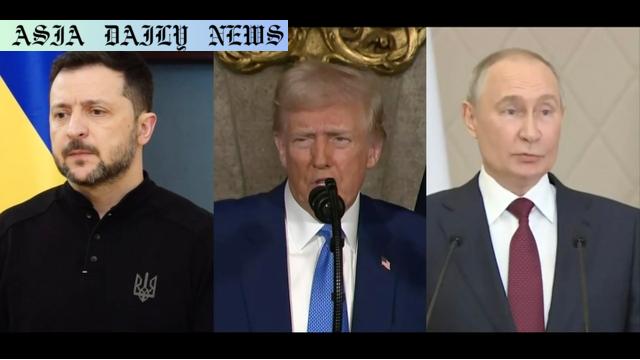Ceasefire – Zelenskyy expresses hope for progress toward ceasefire after meeting Trump at the Vatican.
- Zelenskyy and Trump held a 15-minute meeting at the Vatican.
- Zelenskyy expressed hope for a ceasefire and lasting peace.
- The Trump administration may propose recognizing Crimea as Russian.
- Trump criticized Putin, hinting at possible new sanctions.
- The discussions marked a potential turning point in relations.

Introduction: A Crucial Meeting at the Vatican
The recent meeting between Ukrainian President Volodymyr Zelenskyy and US President Donald Trump at St. Peter’s Basilica in the Vatican has reignited hope for peace in the Ukraine-Russia conflict. Taking place just before the funeral of Pope Francis, this brief yet significant meeting lasted for 15 minutes and touched on critical topics of global significance. It was their first face-to-face meeting since their contentious discussion at the White House in February, which ended in a heated argument. Zelenskyy’s optimistic remarks following the meeting, coupled with the White House’s description of the discussion as “very productive,” have raised expectations for potential progress toward a ceasefire.
Zelenskyy’s Vision for Peace
Zelenskyy has been vocal about his desire for a “full and unconditional ceasefire” that ensures lasting peace and prevents future conflicts. He took to social media after the meeting to express hope for tangible results on the topics discussed, describing the interaction as having the “potential to become historic.” This optimism resonates deeply with many Ukrainians, who have endured nearly a decade of instability and violence since Russia’s annexation of Crimea in 2014. Zelenskyy’s emphasis on reliable and lasting peace underscores Ukraine’s commitment to pursuing diplomatic solutions to end the conflict.
Trump’s Stance and the Proposed Peace Plan
The Trump administration reportedly proposed a peace plan under which the United States might officially recognize Russian control over Crimea, a move that could be controversial both domestically and internationally. While it remains unclear whether this proposal was discussed during Saturday’s meeting, it could represent a significant shift in US policy toward the conflict. Trump, for his part, criticized Russian President Vladimir Putin for missile attacks on civilian areas in Ukraine, suggesting that Putin may not be genuinely interested in ending the war. Trump also hinted at the possibility of imposing additional sanctions on Russia, a move that would align with his administration’s broader strategy of applying economic pressure to achieve diplomatic goals.
Implications for Ukraine, Russia, and Global Stability
Any discussions about recognizing Crimea as Russian territory are likely to provoke strong reactions from the international community, particularly NATO allies and European nations that have consistently opposed Russia’s annexation of the region. For Ukraine, accepting such a proposal could be seen as a betrayal of its territorial integrity and national sovereignty. Conversely, rejecting the proposal could jeopardize US support and further complicate efforts to negotiate a ceasefire. The delicate balance of these dynamics highlights the complexities of international diplomacy and the challenges of achieving peace in the region.
The Path Forward
As the world watches closely, the outcome of these discussions could have far-reaching implications for the Ukraine-Russia conflict and global geopolitics. The meeting between Zelenskyy and Trump represents a critical step in the ongoing effort to resolve the crisis, but much work remains to be done. Whether through diplomatic negotiations, economic sanctions, or other means, the path to peace will require sustained commitment and collaboration from all parties involved. For Ukraine, achieving a lasting ceasefire and durable peace is not just a political priority but a moral imperative for the millions of citizens who have suffered the devastating consequences of war.



Commentary
The Significance of High-Level Diplomacy
The recent meeting between Presidents Zelenskyy and Trump serves as a potent reminder of the power of diplomacy in resolving even the most intractable conflicts. The importance of dialogue cannot be overstated, particularly in the context of the Ukraine-Russia conflict, which has caused immense human suffering and geopolitical instability. While the brevity of their 15-minute discussion may raise questions about its depth, the very act of meeting and exchanging ideas is a critical step toward building mutual understanding and, ultimately, achieving peace.
The Challenges of Achieving a Ceasefire
A “full and unconditional ceasefire” is a noble goal, but it is fraught with challenges. Both Ukraine and Russia have deeply entrenched positions, and any agreement will require significant compromises from both sides. The reported US proposal to recognize Crimea as Russian territory could add another layer of complexity, as it would likely face strong opposition from Ukraine and its allies. It is worth noting, however, that achieving peace often requires bold and unconventional solutions that can break through the stalemate of prolonged conflict.
The Role of International Leadership
Leadership on the global stage is critical in times of crisis, and both Zelenskyy and Trump have an opportunity to demonstrate statesmanship by prioritizing peace over politics. The war in Ukraine is not just a regional issue; it has global implications, from the disruption of energy markets to the erosion of international norms regarding sovereignty and territorial integrity. By working together, the United States and Ukraine can set an example for how nations can collaborate to address complex challenges in an increasingly interconnected world.
Hope for the Future
While it is too early to assess the full impact of the Vatican meeting, the optimism expressed by Zelenskyy provides a glimmer of hope for the future. History has shown that even the most entrenched conflicts can be resolved through sustained dialogue and international cooperation. Whether this meeting will indeed prove “historic” remains to be seen, but it is a reminder that, even in the darkest times, the possibility of peace is never entirely out of reach.